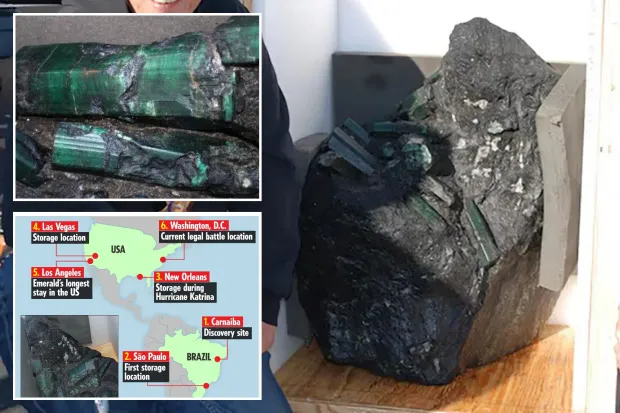The Bahia Emerald, a colossal 397-kilogram gemstone reputed to be the world’s largest emerald, is finally set to return to its homeland, Brazil, after more than two decades of legal wrangling and international controversy.
Valued at an astonishing $1 billion, the gemstone’s journey has been fraught with intrigue, betrayal, and high-stakes courtroom battles, making it one of the most extraordinary sagas in the world of precious stones.
The recent ruling by US District Judge Reggie B. Walton has brought this epic to a close, ensuring that the emerald will return to Brazil, a victory for a nation that has long fought to reclaim its cultural and natural heritage.
The Early Years: Discovery and Extraction
The story of the Bahia Emerald begins in 2001 when it was discovered in the mineral-rich region of Bahia, Brazil. This region, known for its wealth of natural resources, has produced some of the world’s most remarkable gemstones.
However, the discovery of this particular emerald was anything but ordinary. Weighing nearly 400 kilograms and comprising several massive emerald crystals, it quickly became a coveted treasure.
Read : In the lap of nature Exploring Brazil’s Top Ten Most Beautiful Villages
The Bahia Emerald was illegally extracted from its homeland, a process shrouded in secrecy and likely involving local miners and smugglers. It wasn’t long before the gemstone made its way out of Brazil and into the international black market, setting the stage for a complex and controversial saga.
A Journey Marked by Misfortune
The Bahia Emerald’s journey from Brazil to the United States was nothing short of dramatic. Almost immediately after its removal, stories of misfortune began to follow the gemstone, contributing to its reputation as “cursed.”
One of the most infamous incidents occurred during its transport through the dense Brazilian jungle, where it reportedly survived a panther attack. This bizarre tale was only the beginning of a series of strange and sometimes tragic events.
Read : Two Influencers Drown in Brazil After Refusing to Wear Life Jacket as It Would Ruin Selfies
In 2005, the Bahia Emerald was stored in New Orleans, where it narrowly escaped destruction during Hurricane Katrina. The flooding that devastated the city came perilously close to submerging the emerald, but it survived, adding another chapter to its legend of resilience and misfortune.
These events, combined with the gemstone’s involvement in a series of legal and criminal disputes, cemented its reputation as a cursed object.
The Legal Battle: Decades of Disputes and Drama
The legal battle over the Bahia Emerald began almost as soon as it arrived in the United States. Multiple parties claimed ownership, each presenting their version of events and their stakes in the gemstone. At the heart of the dispute was the question of how the emerald was acquired and who had the rightful claim to it.

The gemstone eventually ended up in the custody of the Los Angeles Sheriff’s Department, where it remained for more than 15 years. During this time, a protracted legal battle unfolded, involving American investors, Brazilian authorities, and various intermediaries.
Among the most prominent claimants was Kit Morrison, an Idaho businessman who invested $1.3 million, hoping to profit from the sale of the Bahia Emerald. Morrison and other investors argued that they had legitimate claims based on their financial investments and contractual agreements.
However, the Brazilian government maintained that the emerald was a national treasure that had been illegally removed from the country. They argued that the gemstone’s removal violated Brazilian laws and that it should be returned to its rightful home. This claim was supported by a forfeiture order issued by a Brazilian court, which sought the emerald’s repatriation.
The US government, acting under the Mutual Legal Assistance Treaty (MLAT) with Brazil, supported the Brazilian claim. The MLAT facilitates cooperation between nations in legal matters, and in this case, it played a crucial role in ensuring that the Brazilian government’s efforts were taken seriously by US courts.

In his ruling, Judge Reggie B. Walton emphasized the importance of enforcing the Brazilian forfeiture judgment. “The Court has concluded that the Intervenors’ positions are insufficient to prohibit the return of the Emerald to Brazil,” he stated. This ruling effectively ended the claims of the American investors and cleared the way for the emerald’s return to Brazil.
The Cultural Significance and Symbolism
For Brazil, the return of the Bahia Emerald is more than just a legal victory; it is a matter of national pride and cultural heritage. The emerald is seen as a symbol of Brazil’s rich natural resources and the need to protect them from exploitation and smuggling. Its return underscores the importance of preserving cultural artifacts and ensuring that they remain in their countries of origin.
Boni de Moraes Soares, a federal prosecutor from Brazil, expressed his satisfaction with the court’s decision, stating, “We’re very happy with the decision. We’re closer than ever to bringing the Bahia Emerald back to the Brazilian people.”
This sentiment reflects a broader effort by Brazil to reclaim its cultural heritage and prevent the illegal export of valuable resources.

The gemstone’s return is expected to have a significant impact on Brazil’s cultural landscape. Plans are already underway to display the Bahia Emerald in a museum, where it will be accessible to the public.
This move is not just about showcasing a valuable artifact; it is about educating people on the importance of protecting natural resources and cultural heritage.
Lessons from the Bahia Emerald Saga
The Bahia Emerald’s story raises important questions about the ethics of investing in culturally significant artifacts and the responsibilities of nations in preserving their heritage. The case highlights the challenges faced by countries like Brazil, which are often rich in natural resources but vulnerable to exploitation and smuggling.
For investors like Kit Morrison, the case represents the complexities of dealing with high-value assets that have questionable origins. Morrison’s response to the court’s ruling was notably philosophical.
“I don’t have any feeling of defeat or loss,” he said. “When you are an investor and entrepreneur, you do everything you can to protect, preserve, and improve the investment and opportunity. However, you cannot control the things that are out of your control.”

This perspective underscores the risks involved in such investments and the need for due diligence. It also highlights the ethical considerations that come into play when dealing with artifacts that have cultural and historical significance.
The Future of Cultural Repatriation
The Bahia Emerald’s return to Brazil sets a significant precedent for future cases involving the repatriation of cultural artifacts. It demonstrates the importance of international cooperation and the role of legal frameworks like the Mutual Legal Assistance Treaty in resolving complex disputes.
This case also serves as a reminder of the ongoing struggle to protect cultural heritage from exploitation. Many countries continue to face challenges in reclaiming artifacts that have been illegally removed and sold on the black market. The return of the Bahia Emerald is a victory not just for Brazil but for all nations seeking to protect their cultural heritage.
The Bahia Emerald’s journey has been one of intrigue, misfortune, and relentless legal battles. From its illegal extraction in Brazil to its dramatic transport across continents and its long custody battle in the United States, the emerald’s story is a testament to the complex intersection of wealth, heritage, and international law.
As Brazil prepares to welcome the emerald back, the gemstone’s legacy will live on—not just as a valuable artifact but as a symbol of resilience, cultural pride, and the enduring fight to protect national treasures.
let’s enjoy few years on earth with peace and happiness….



